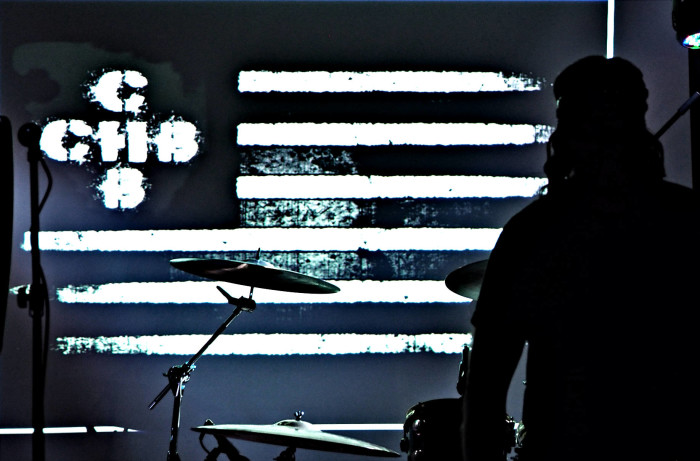If an acoustical environment changes significantly, you may start to have mysterious problems.
Please Remember:
The opinions expressed are mine only. These opinions do not necessarily reflect anybody else’s opinions. I do not own, operate, manage, or represent any band, venue, or company that I talk about, unless explicitly noted.

 Want to use this image for something else? Great! Click it for the link to a high-res or resolution-independent version.
Want to use this image for something else? Great! Click it for the link to a high-res or resolution-independent version.Just recently, I was working a show for Citizen Hypocrisy. I did my usual prep, which includes tamping down the “hotspots” in vocal mics – gain before feedback being important, and all that.
Everything seemed copacetic, even the mic for the drumkit vocal. There was clarity, decent volume, and no ringing. The band got in the room and set up their gear. This time around, an experiment was conducted: A psychedelic background video was set to play in a loop as a backdrop. We eventually did a quick, “just in time” soundcheck, and we were off.
As things kicked into gear, I noticed something. I was getting high frequency feedback from one of the mics, it wasn’t running away by any means, but it was audible and annoying. I thought to myself, “We did just give DJ’s microphone a push in monitor world. I probably need to pull the top-end back a bit.” I did just that…but the feedback continued. I started soloing things into my headphones.
“Huh, guitar-Gary’s mic seems okay. DJ’s mic is picking up the feedback, but it doesn’t seem to be actually part of that loop. That leaves…*unsolos DJ’s mic, solos drum-Gary’s mic* Well, THERE’S the problem.”
The mic for vocals at the drumkit? It was squeaking like a pissed-off mouse. I hammered the offending frequency with a notch filter, and that was it.
But why hadn’t I noticed the problem when I was getting things baselined for the night? Gary hadn’t changed the orientation of the mic so that it was pointing at the drumfill, and neither the input gain nor send gains had changed, so why had the problem cropped up?
The answer: Between my setup and actually getting the show moving in earnest, we had changed the venue’s acoustical characteristics, especially as they concerned the offending microphone. We had deployed the screen behind the drums.
Rolling With The Changes
Citizen Hypocrisy was playing at my regular gig. Under conditions where we are NOT running video, the upstage wall is a mass of acoustical wedge foam. For most purposes, high-mid and high frequency content is soaked up by the treatment, never to be heard again. However, when we are running video, the screen drops in front of the foam. For high frequencies, the screen is basically a giant, relatively efficient reflector. My initial monitor-EQ solution was built for the situation where the upstage wall was an absorber. When the screen came down, that solution was partially invalidated. Luckily, what had to be addressed was merely the effective gain of a very narrow frequency range. We hadn’t run into a “showstopper bug,” but we had still encountered a problem.
The upshot of all this is:
Any change to a show’s acoustical environment, whether by way of surface absorption, diffusion, and reflectance, or by way of changes in atmospheric conditions, can invalidate a mix solution to some degree.
Now, you don’t have to panic. My feeling is that we sometimes overstate the level of vigilance required in regards to acoustical changes at a show. You just have to keep listening, and keep your brain turned on. If the acoustical environment changes, and you hear something you don’t like, then try to do something about it. If you don’t hear anything you don’t like, there’s no reason to find something to do.
For instance, at my regular gig, putting more people into the room is almost always an automatic improvement. I don’t have to change much (if anything at all), because the added absorption makes the mix sound better.
On the reverse side, I once ran a summer show for Puddlestone where I suddenly had a “feedback monster” where one hadn’t existed for a couple of hours. The feedback problem coincided with the air conditioning finally getting a real handle on the temperature in the room. My guess is that some sort of acoustical refraction was occurring, where it was actually hotter near the floor where all the humans were. For the first couple of hours, some amount of sound was bending up and away from us. When the AC really took hold, it might have been that the refraction “flattened out” enough to get a significant amount of energy back into the mics. (My explanation could also be totally incorrect, but it seems plausible.) Obviously, I had to make a modification in accordance with the problem, which I did.
In all cases, if things were working before, and suddenly are no longer working as well, a good question to ask yourself is: “What changed between when the mix solution was correct, and now, when it seems incorrect?” It’s science! You identify the variable(s) that got tweaked, and then manage the variables under your control in order to bring things back into equilibrium. If you have to re-solve your mix equation, then that’s what you do.
And then you go back to enjoying the show.
Until something else changes.